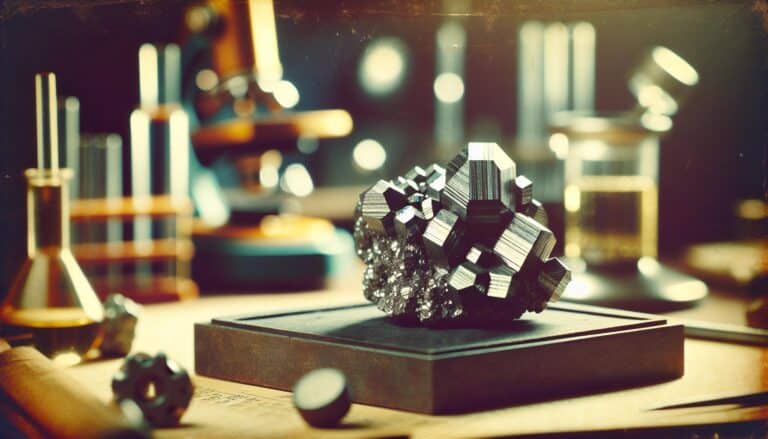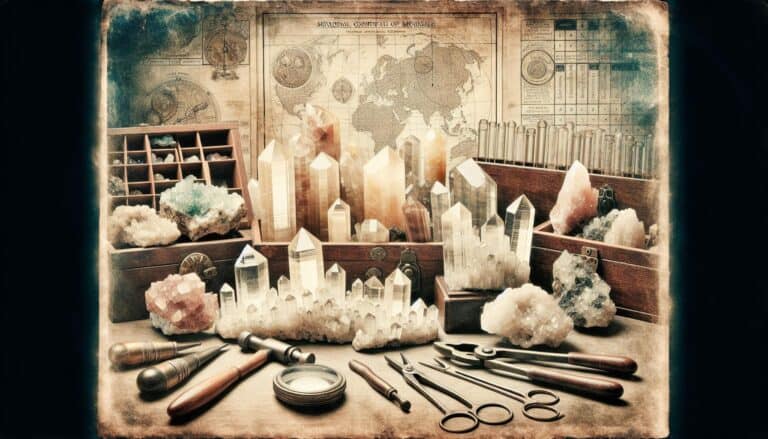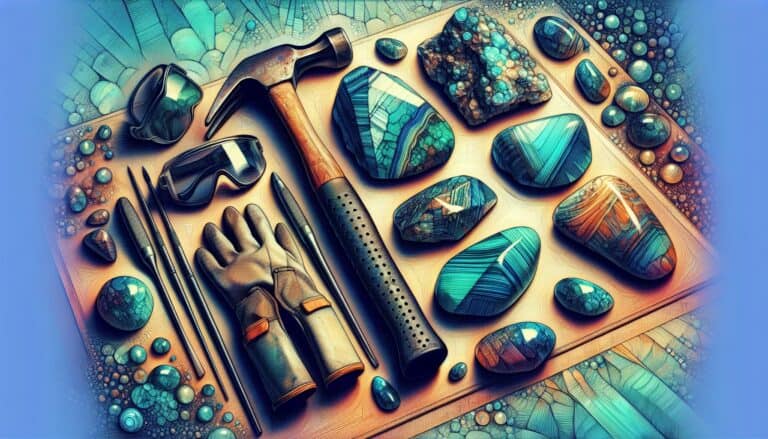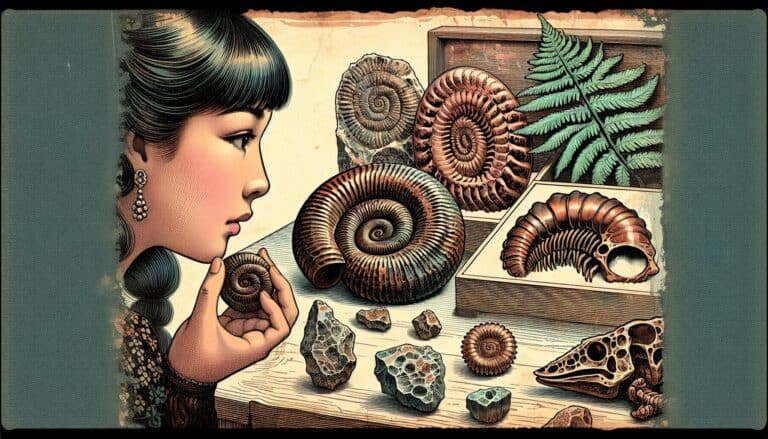Discovering the secrets of identifying genuine turquoise can be as mesmerizing as the stone itself.
You’re about to unlock the mystery behind this captivating gemstone. Whether you’re a collector or just someone who appreciates the beauty of turquoise, knowing how to spot the real deal is crucial.
To identify genuine turquoise, inspect for a waxy luster and matrix patterns, test its hardness (5-6 on the Mohs scale), and check for non-magnetism. Turquoise leaves a sky-blue streak, is non-birefringent, and typically opaque. It exhibits single refraction and has a specific gravity of 2.6-2.9.
Turquoise vs Raw Turquoise
Raw turquoise and turquoise, although closely connected, exhibit differences in their appearance, composition, and utility. Raw turquoise represents the unaltered state of this mineral as it occurs naturally in the Earth. It typically manifests as unrefined stones with diverse colors, spanning from greenish-blue to sky blue, often containing veins or matrix, which are intermixed with other minerals or rocks.
Conversely, turquoise denotes the same mineral after undergoing various processing steps, like cutting, polishing, and occasionally stabilization, to enhance its resilience and aesthetics. This transformation results in a smoother texture, more vibrant coloration, and increased suitability for crafting jewelry and ornamental items.
Turquoise, whether in its raw or processed form, has held significant value for its beauty and cultural importance throughout history. Frequently used in jewelry, especially in designs rooted in Native American and Southwestern traditions, it is also prevalent in art and sculpture.
Turquoise is imbued with metaphysical significance, symbolizing concepts like protection, healing, and wisdom, rendering it not merely a captivating gemstone but also a cherished cultural and spiritual emblem. Ultimately, the choice between raw turquoise and processed turquoise hinges on personal preferences and intended applications, with both varieties offering their distinct allure and appeal.
How to Identify Turquoise Through Testing
Visual Inspection
Start by examining the turquoise’s surface. Genuine turquoise typically has a waxy luster and an intricate web of matrix patterns. Look for uniformity; real turquoise will often have an irregular, non-uniform appearance, while imitations may appear too perfect. Compare it to Raw turquoise.
The Streak Test
To perform the streak test, rub your turquoise against a piece of unglazed porcelain. Real turquoise will leave a sky-blue streak, while an imitation might not leave any streak or show a different color.
Magnet Test
Turquoise is not magnetic, so if the stone attracts a magnet, it’s a sign that your specimen may contain other minerals or has been altered, signifying a fake.
Hardness Test
Turquoise has a Mohs hardness of about 5 to 6. Test your stone against a piece of glass (which has a Mohs hardness of about 5.5). Genuine turquoise should be able to scratch the glass.
Birefringence Test
Birefringence refers to a mineral’s property to refract light in two different directions. Turquoise is typically non-birefringent, which means if you’re getting double images, chances are it’s not authentic.
Checking The Diaphaneity
Examine the transparency of the stone under a strong light. Authentic turquoise is generally opaque, rarely translucent. If the stone allows light to pass through it may not be true turquoise.
Single or Double Refraction
Genuine turquoise exhibits single refraction. If a double refraction is observed when looking through a gemstone refractometer, this could indicate an imitation.
Refractive Index Test
A refractive index test may require specialized equipment. Turquoise has a refractive index range of approximately 1.61 to 1.65. Values outside of this range may suggest the stone is not genuine.
Finding The Specific Gravity
The specific gravity of turquoise is around 2.6 to 2.9. Weighing your stone and calculating the specific gravity can help determine if it aligns with the characteristics of turquoise.
Identifying Turquoises in the Field
When searching for turquoise in the field, look for secondary deposits in copper mining areas. Check for stones with blue-to-green colors and a matrix-type pattern embedded within.
Recognizing Potential Turquoise Rocks
In their natural state, potential turquoise rocks have tell-tale signs such as a chalky, bluish-green color and a matrix webbing. These rocks may also be found in arid regions alongside copper deposits.
Physical Characteristics of Turquoise

When identifying turquoise, key physical features offer crucial clues. The gemstone usually has a waxy to subvitreous luster, which means it’s not as shiny as glass but has a noticeable sheen. Its colors can vary, displaying hues from sky blue to green due to the presence of copper and iron.
Turquoise’s unique texture can be either smooth or webbed. The webbing, also known as matrix, is the remnant of the host rock and varies from intricate spider web patterns to random streaks. The presence and style of matrix can influence both the value and authenticity of the stone.
One of the hallmark features of turquoise is its durability, although it’s relatively softer than many other gemstones. With a Mohs hardness scale rating of 5 to 6, turquoise is just hard enough to be carved and sculpted into beautiful shapes for jewelry.
To further identify turquoise:
- Weigh the stone. Turquoise has a specific gravity of 2.6 to 2.9, which helps distinguish it from imitations.
- Examine any signs of artificial treatments. Stabilized turquoise, common in the market, has a harder texture due to the added resins.
Remember, characteristics like irregular color distribution and variations in the matrix are common and often indicate a natural origin. Keep these aspects in mind as you explore and verify the authenticity of turquoise through the methods previously discussed.
How Are Turquoise Formed?
Turquoise is a hydrous phosphate of copper and aluminum. Its formation is as fascinating as its vibrant blue and green hues. You’ll find that these stones take shape over millions of years, under very specific geological conditions. Typically, turquoise develops in arid regions, where the weathering processes of the earth’s crust dissolve copper out of certain rock types.
In areas rich in copper deposits, the precipitation of copper-laden groundwater into subsurface rock voids is a critical step. This process is accompanied by the introduction of phosphorus and aluminum, usually sourced from the breakdown of nearby apatite. Over time, the interactions between these elements, along with water, lead to the crystallization of turquoise.
The conditions have to be just right, with stable temperatures and a fine balance of acidity and alkalinity in the water to ensure turquoise formation. Interestingly, it’s this unique variety of factors that contribute to the stone’s rarity and value.
When exploring potential areas for turquoise, you may come across telltale signs of its occurrence. Look for staining on rocks, known as a patina, which can indicate the presence of copper minerals below. Also, zones of rock alteration, often visible as color changes in the rock, can signal that the necessary mineralizing processes have occurred.
Preparation for Turquoise Hunting
Before heading out on your quest for genuine turquoise, ensuring you’re well-prepared is vital. Not only will the right tools and safety measures make your hunt more productive, but they’ll also prevent any unnecessary mishaps.
Gathering the Right Tools
Embarking on a turquoise hunting adventure requires more than just enthusiasm. You’ll need a toolkit that enhances your ability to identify and collect samples. Here’s what you should include:
- Geologist’s hammer or pick: Essential for extracting rock samples.
- Chisels and sledgehammers: Useful for breaking larger rock formations.
- Shovel or spade: To dig through soil and uncover hidden treasures.
- Safety glasses and gloves: To protect your eyes and hands during excavation.
- Portable scale: To weigh your finds and assess density variations.
- Magnet: To perform a quick magnet test.
- Scratch plate: For conducting a streak test.
- Field guide: To reference the properties of turquoise and assist with identification.
Having this equipment will help you discern genuine turquoise from lookalikes and ensure you’re collecting quality specimens.
Safety Considerations
Safety should never be overlooked, especially when hunting for minerals such as turquoise. Take note of these safety tips:
- Wear appropriate clothing: Durable boots, long pants, and protection against the sun.
- Use sunscreen and a hat: To guard against sunburn during long hours outdoors.
- Stay hydrated: Carry plenty of water to prevent dehydration.
- Inform someone of your whereabouts: Always let someone know where you’re going and when you plan to return.
- Watch for wildlife: Be aware of your surroundings and any potential dangers from animals or insects.
- Carry a first aid kit: Always be prepared for minor injuries or emergencies.
By following these safety precautions, you’ll minimize risks and focus more on the rewarding aspects of turquoise hunting.
Handling and Care of Found Turquoise

Proper handling and care are essential in protecting the value and beauty of your found turquoises. It’s not just about recognizing the precious stone but also about preserving its quality from the moment you find it.
Cleaning and Storing Turquoises
Once you’ve successfully identified and collected turquoises, the immediate next step is to clean them. Dirt and debris from the field can obscure the stone’s true luster. Begin by using a soft brush to gently remove any loose dirt. It’s important to avoid harsh chemicals or ultrasonic cleaners as they can damage the stone’s surface.
For a deeper clean, mild soap and lukewarm water are recommended. Soak the stone for a few minutes before softly brushing it clean. Always rinse thoroughly with clean water to remove any soap residue. Subsequently, pat your turquoises dry with a lint-free cloth to prevent any water spots or streaks.
When it comes to storing your turquoises, keeping them away from direct sunlight and high temperatures is crucial as these factors can cause the stones to fade or crack. Ideally, wrap the stones individually in a soft cloth. This prevents them from scratching each other or being scratched by harder stones if you’re storing them together.
For long-term storage, consider using a fabric-lined jewelry box or a compartmentalized container. Each turquoise piece should have its own section to prevent contact with other stones, which might damage your finds. Maintaining a stable environment with moderate temperature and humidity levels is key to ensuring your turquoises stay vibrant and intact for years.
Remember to handle your turquoises with care. Abrasive surfaces and sharp impacts can cause scratches or fractures in the stone. When wearing or handling your finds, be mindful of the activities you engage in. Turquoise is best kept away from high-impact situations where it could be damaged.
By following these straightforward cleaning and storing guidelines, you’ll help to preserve the natural allure and value of your turquoise discoveries.
Conclusion: Confirming Turquoise is Real
Armed with the knowledge you’ve gained, you’re now well-equipped to distinguish real turquoise from imitations.
Remember that careful observation and testing are key to confirming authenticity. Whether you’re out in the field or examining a piece at home, your newfound understanding will help you appreciate the true beauty of genuine turquoise. Always handle your finds with care to maintain their allure for years to come.
Happy hunting and treasure your turquoise discoveries!







